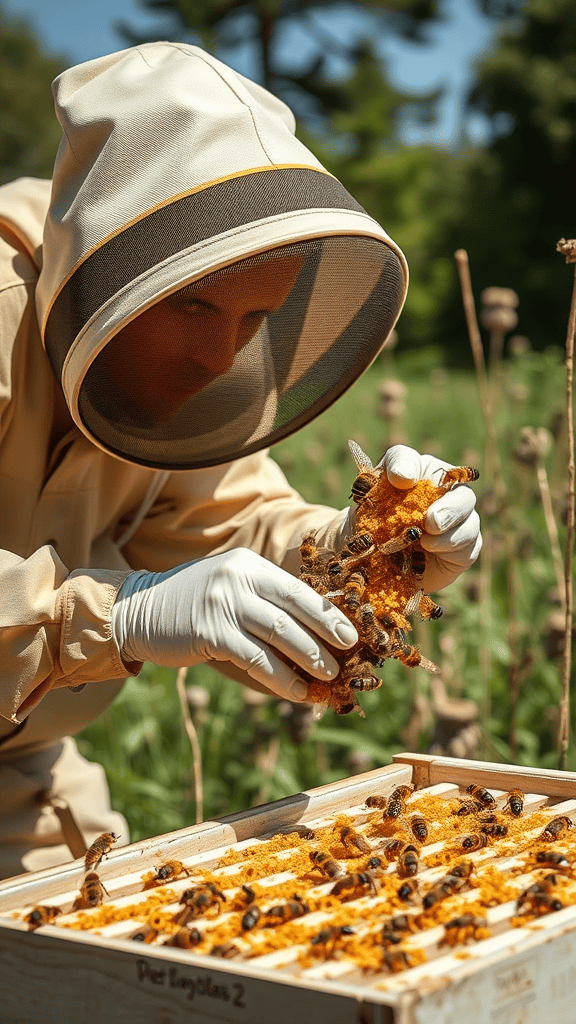The Role of Technology in Precision Beekeeping
The world of beekeeping is entering a new era thanks to advancements in technology. This movement, known as precision beekeeping, harnesses various tools and innovations to enhance hive management and improve the overall health of bee colonies. By understanding the role of technology in this field, beekeepers can be more efficient and effective, ensuring that their bees thrive.
At the heart of precision beekeeping is the use of various monitoring devices. These gadgets collect and analyze data from the hive, enabling beekeepers to make informed decisions. For instance, temperature and humidity sensors can signal when conditions inside the hive may become unfavorable. By keeping a close eye on these metrics, you can take action before issues arise, thus promoting a healthier environment for your bees.
Another beneficial element of technology in precision beekeeping is the use of image analysis. Advanced cameras and drones can monitor hive activity and bee behavior. With the help of machine learning, beekeepers can analyze images to track bee movement, assess colony strength, and even spot signs of disease. This proactive approach allows you to intervene early and maintain the health of your colonies.
Wearable tech is also making its mark in the beekeeping community. Wearable devices can track a beekeeper’s personal health data while they work near the hives. This is particularly beneficial during the warmer months when the sun can take a toll on your physical well-being. By managing your health efficiently, you can dedicate more time and energy to looking after your bees.
The development of mobile applications is another significant aspect of technology’s role in precision beekeeping. These applications allow beekeepers to log and track various hive activities, such as feeding schedules, pests, and honey production levels. With this digital record-keeping, you can quickly reference past hive conditions and trends, which makes managing the colonies much easier.
- Data Collection: Applications provide easy access to historical data that aid in making decisions.
- Alerts and Notifications: Get real-time alerts on hive conditions or unusual behaviors.
- Community Interaction: Connect with other beekeepers to share insights and strategies.
One of the most exciting developments in precision beekeeping is the use of artificial intelligence (AI). AI algorithms can analyze data collected from sensors and cameras, providing insights about what might be best for each specific hive. This technology can make predictions on the best times to harvest honey or when to introduce new bees. This tailored approach maximizes productivity while minimizing stress on the colonies.
Additionally, GPS technology plays a vital role in precision beekeeping. GPS tracking can not only help you locate your hives in remote areas but also offer insights on foraging patterns. Understanding where your bees are going for nectar and pollen can help you plan your hive placement more effectively. Better hive placement leads to more efficient foraging and improves honey production overall.
However, technology isn’t just about monitoring and data collection. It also extends to hive management tools. Automated feeders and pest control systems help reduce the time spent on manual labor. These innovations free you up to focus on other important tasks while ensuring your hive gets the right nutrients and remains pest-free.
It’s essential to remember that while technology plays a crucial role, it should complement traditional beekeeping practices rather than replace them. The combination of human intuition, experience, and advanced tools creates a more sustainable practice. As a beekeeper, you can benefit tremendously by integrating these technological advancements into your daily routine.
In this rapidly evolving field, staying informed about the latest technology can set you apart as a beekeeper. Consider investing in some of these tools and practices to enhance your beekeeping experience. With technology at your fingertips, you can look forward to healthier bee colonies and a more fruitful honey production season.
Technology has transformed precision beekeeping, allowing for better monitoring, effective management, and smarter decision-making. By embracing these innovations, you enhance not only your understanding of bee health but also the vitality of your bee colonies for future generations.
Benefits of Precision Beekeeping for Honey Production and Pollination
Precision beekeeping is revolutionizing the way we understand and manage honeybee populations. By utilizing advanced technology and targeted strategies, beekeepers can enhance honey production and improve pollination efficiency. This modern approach offers a range of benefits that can significantly boost both the yield of honey and the effectiveness of pollinators in agricultural settings.
One major benefit of precision beekeeping is the enhanced ability to monitor hive health. With the introduction of sensors and data analysis tools, beekeepers can track vital signs within the hives. These tools can detect temperature fluctuations, humidity levels, and even the sounds made by bees. By actively monitoring these factors, you can identify potential issues before they escalate, ensuring that the bees remain healthy and productive.
Optimizing Honey Production
Precision beekeeping plays a critical role in optimizing honey production. Understanding the needs of bees through real-time data allows for better-informed decisions regarding feeding, medication, and environmental conditions. Consider the following advantages:
- Targeted Nutrition: With precision beekeeping, beekeepers can analyze the nutritional requirements of their hives, providing supplemental feeding when necessary. This targeted approach ensures bees have the energy to produce more honey.
- Effective Disease Management: Monitoring hive health leads to early detection of diseases. By addressing health issues promptly, you limit honeybee losses and maintain stable honey production levels.
- Time Management: Precision tools allow for efficient hive inspections without disturbing the bees excessively. This means less stress for the bees and more time devoted to honey extraction processes.
Enhancing Pollination Efficiency
Pollination is another critical area where precision beekeeping shines. Honeybees are essential for the pollination of a vast number of crops, contributing to global food production. The use of precision techniques can enhance pollination in several key ways:
- Foraging Patterns: By analyzing foraging behavior, you can determine the optimal times and conditions for bees to pollinate crops. This information allows farmers to plan accordingly, maximizing yields.
- Coordinated Hive Placement: Data insights can guide hive placement close to crops that require pollination. Properly situating hives can drastically increase pollination efficiency, benefiting both the beekeeper and farmers.
- Informed Crop Choices: Understanding how bees interact with different flowering plants can help in selecting crop varieties that will thrive best with targeted pollination efforts.
Environmental Sustainability
Adopting precision beekeeping practices also contributes to environmental sustainability. By collecting data on hive performance and bee behavior, beekeepers can better understand the interplay between bee health and the surrounding environment. Here are some sustainable advantages:
- Reduced Chemical Use: With timely health monitoring, you can minimize pesticide treatment and only apply when absolutely necessary, reducing chemical exposure for bees.
- Enhanced Biodiversity: Educating beekeepers on the ecological needs of bees leads to better habitat management, encouraging biodiversity in both bee populations and plant species.
- Resource Efficiency: Accurate data on hive performance helps you allocate resources more efficiently, reducing waste and promoting long-term ecological balance.
A wider adoption of precision beekeeping enables a paradigm shift in how we view beekeeping and agriculture. By blending technology with traditional beekeeping methods, you can create a system that not only boosts honey production but also enhances pollination efforts vital for food security. The benefits are far-reaching, suggesting a brighter future for bees, farmers, and consumers alike.
Embracing precision beekeeping is not just an innovation; it is a necessity in today’s world. With its focus on data-driven decision-making and sustainable practices, this approach paves the way for a thriving beekeeping industry that supports both ecological balance and agricultural productivity. Whether you’re a seasoned beekeeper or a novice, integrating precision techniques can elevate your beekeeping game and make a real difference in honey production and pollination efficiency.
Conclusion
As we delve deeper into the world of precision beekeeping, it becomes clear that technology has revolutionized how we engage with these essential pollinators. Employing smart tools and advanced data analytics not only enhances beekeeping efficiency but also fosters a deeper connection with the bees. With real-time monitoring capabilities, beekeepers can respond promptly to the needs of their hives, ensuring optimal health and productivity.
The benefits of precision beekeeping extend far beyond mere honey production. As we face increasing challenges in agriculture and the environment, the role of honeybees in pollination becomes even more vital. By maximizing honey yield while ensuring that bees thrive, this innovative approach ultimately supports biodiversity and food security.
Adopting precision practices can lead to sustainable beekeeping, where both the apiarist’s goals and the bees’ well-being are prioritized. This balance ensures that we can enjoy the rewards of honey and the essential services bees provide for crop production. As beekeepers embrace these technologies, they pave the way for a more sustainable future, transforming beekeeping into a data-driven, efficient, and environmentally-friendly practice.
With every innovation in precision beekeeping, we not only safeguard the health of our hives but also contribute to a greater understanding of the intricate ecosystems these tiny creatures support. As we move forward, staying informed and adaptable in our practices will be key to nurturing our relationship with honeybees, ensuring they remain a thriving part of our agricultural landscape.
As an Amazon Associate, I earn from qualifying purchases.

